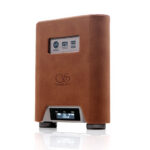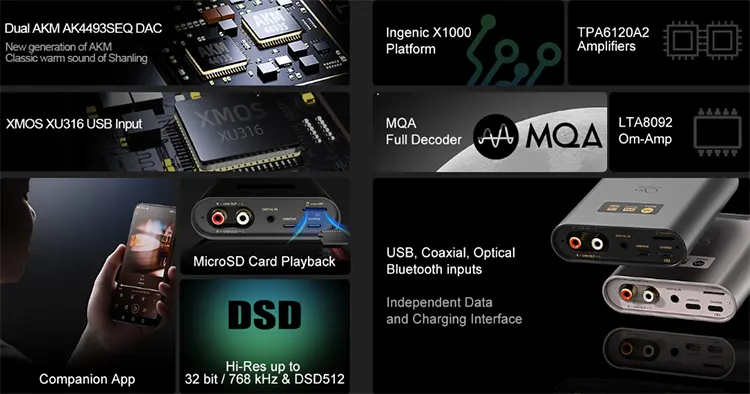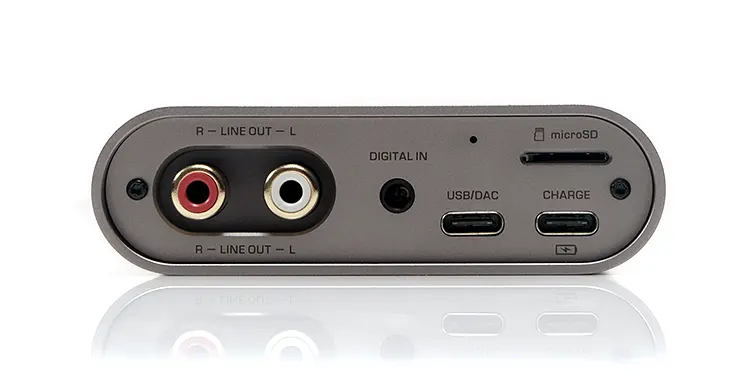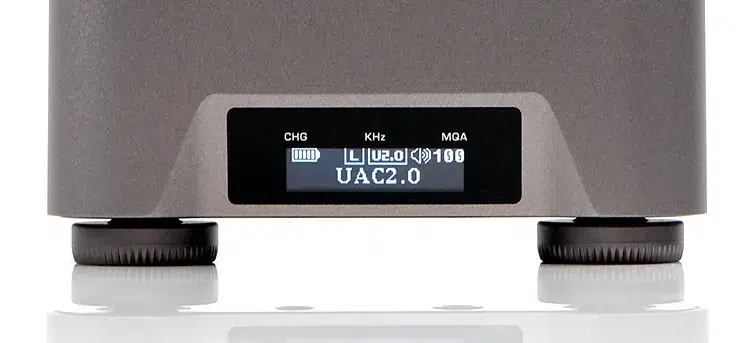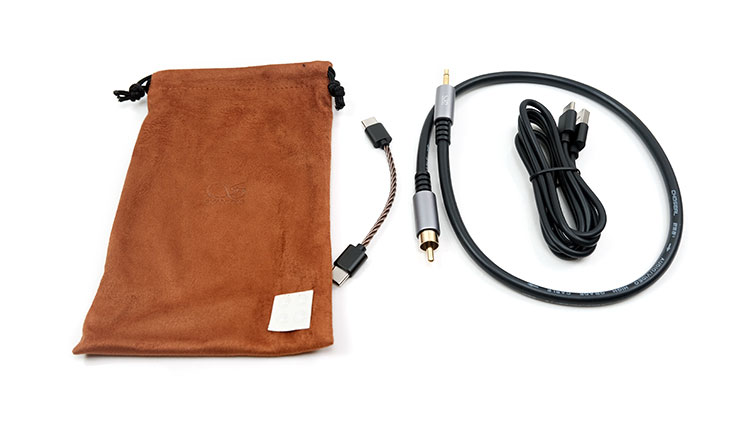We review the Shanling H5, which is a portable dual AK4493S DAC and balanced headphone amplifier with local storage and wireless capability. It is priced at $369.99.
Disclaimer: This sample was sent to us in exchange for our honest opinion. Headfonics is an independent website with no affiliate links or status. We thank Shanling for their support.
To learn more about Shanling products we previously discussed on Headfonics click here.
Note, that this article follows our latest scoring guidelines which you can read here.
With the recent review of the excellent H7 portable amp and DAC still ringing fresh in my memory, Shanling has swiftly followed that up with a more affordable compact version called the H5.
I was not expecting something like this, at least not so soon but it does provide an option for more frugal audiophiles to get a taste of what the H7 can do, albeit with a fairly different sound signature.
In fact, the local buzz is that some early adopters might actually prefer the tonal qualities of the H5 over the H7. At more or less half the price and including a heck of a lot of the H7 features, that $369.99 SRP of the H5 might well prove to be a bit of a bargain. So, what’s the catch then?
Tech Highlights
Summary
So, what are the capabilities of the H5 then? Like the H7, the H5 is also a compact balanced portable amplifier and DAC with wireless capability. It is primarily designed to pair with IEMs but some headphones should present it with no issues also.
It has a wide range of I/O options to allow it to function in a number of ways including a regular USB-DAC for your PC or MAC as well as connect to your smartphone via OTG. It can also offer a traditional dual RCA line-out with volume attenuation options giving it some preamp capability.
The H5 also connects via Bluetooth and plays audio from almost any compatible Bluetooth transmitter source such as your smartphone or iOS device.
Pleasingly, the excellent onboard storage feature from the H7 has been retained on the H5. You can play audio files locally from an additional microSD slot to the rear with a measure of control via a small menu-based LCD screen and multifunctional dials to the front. Media management can also be done via Eddict giving you an additional DAP-like dimension.
DAC
The Shanling H5 comes equipped with a dual AK4493SEQ DAC implementation which is the same chipset used in last year’s M6 Ultra DAP.
Shanling’s aim was to tune the H5 as close as possible to their usual smooth and warm sound signature so it’s no surprise the M6 Ultra’s nostalgic coloration was used as a benchmark.
Despite the drop from a quad implementation to a dual setup, the H5 is no less capable with a top-tier native DSD512 and PCM 32BIT/768kHz decoding capability via USB. However, if you plan to use the built-in Ingenic X2000-powered 2TB-capable local storage player you will get a lower DSD256 and 32BIt/384kHz capability.
Combined with the same XMOS XU316 USB chipset as the H7, the H5 is also capable of unfolding MQA up to 8X, (only their DAPs are capable of doing 16X currently).
The H5 also offers coaxial and optical SPDIF input decoding up to a maximum of 192kHz/24BIT for coaxial and 96kHz/24BIT for optical.
If you plan to switch to Bluetooth for wireless receiving the decoding will give you an optimal LDAC 24BIT/96kHz which is ideal. However, similar to the H7, the H5 has no aptX or aptX Adaptive so the drop is steep from LDAC down to SBC. In the case of iOS, you get the usual AAC maximum.
Amplifier
There are some pros and cons to the amplification output of the H5 depending on the type of gear you want to use.
On the pro side, and for its price point, the output power is very competitive at 840mW into a 32Ω going balanced and 227mW into the same load when in single-ended mode.
Whilst not as powerful as the 1.3W capability of the flagship H7 it still has plenty of juice to drive any IEM out there and quite a few headphones also. Compared to the benchmark M6 Ultra DAP at 720mW@32ohm balanced, the H5 actually has a bit more headroom.
The con, however, is the output impedance at 4.7Ω single-ended and 6.6Ω balanced when typically, you are looking for 1Ω or less in portable gear.
That means impedance skew for some low-impedance gear is a potential problem with H5 pairings. Less so for high-impedance gear or some types of flat impedance monitors such as the LID-equipped 64 Audio U4s or the Custom Art FIBAE range such as the FIBAE 7 Unlimited.
Design
Form Factor
Imagine the H7 with about 25% chopped off the rear end and that’s the H5. Not so much smaller but rather a bit shorter with similar width and height dimensions. Still the chubbier of the two when compared to the Mojo but still quite ‘single-handed’ friendly.
For those of you new to the concept, the H5 measures in at 102 x 85 x 25 mm and weighs 270g so not insubstantial and heavier than the 180g of the Mojo2 but still just over 80g lighter than the flagship H7.
The only caveat might be from pairing with modern-day smartphones which seemed to suit the longer dimensions of the H7 for stacking purposes.
You can still place a Samsung S23 Ultra on top of the H5 but it’s not as neat a match as the H7 stack. Smaller DAPs such as the Shanling M1s and the M0 Pro, however, are perfect for the squat H5 surface area.
Aesthetics
Despite that, I find it an adorable interpretation of the bigger H7 with a virtual identikit in features save for the missing 6.35mm PO.
You also get a taller but narrower LCD screen with better lighting than the H7 screen. That height now accommodates two lines of text instead of one making the information a bit tidier for me compared to the H7 design.
The body is more of a hip-flask type of design made out of a very smoothly finished anodized aluminum alloy housing so very easy to handle with no sharp cornering anywhere. It gets gorgeously comfortable to hold once you add the optional additional carry case which is made from a very comfortable tanned leather material.
The rear panel is slightly recessed to protect the connectors from accidental drops with more intricate cutting on the front panel and a small LCD panel for the lightweight OS.
On either side are two ALPS pots which have a nice grippy texture to their finishing. The front panel still has that difficult-to-read labeling under a reflective coating drawn from the H7.
I/O
I think what surprises me the most is the lack of any ‘feature-kill’ to get the H5 down to this price point. The I/O save for one omission is virtually the same and that is a very good thing in my book.
The one omission is the lack of 6.35mm PO on the front panel but the 4.4mm balanced and 3.5mm SE outputs remain though slightly further apart on the panel.
Aside from that the H5 rear panel looks exactly the same as the H7 with a 2V dual RCA line-out that can operate either as fixed voltage or with volume attenuation, SPDIF input, 2 USB-C ports for charging, and OTG/USB-DAC functionality. You also have that small MicroSD slot that can hold cards up to 2TB for local playback capability.
For iOS users or those wishing to attach a USB-C lightning cable connection the pin arrangement is slightly different so a regular Lightning cable will not work. Shanling does provide one as an optional costed accessory called the L3 Neotech Pure Silver Audio Cable Type-C Lightning at around $17 on the open market.
Controls
Because the H5 has a small OS system with an LED display there is a measure of interaction with it beyond simple power on/off and volume control.
The two Alps pots on either side pretty much do everything you need to manage volume, switch between modes and features, as well as a limited amount of local playback control.
Aside from the panel visual feedback you also get a number of small LED diodes above indicating charging status, sample rate, and if the MQA option is activated during playback.
The main LED panel will round-robin your available modes at the bottom as well as indicative volume level, gain, and battery life remaining at the top.
The precise grouping of controls is split between the two pots which double up as multifunction buttons when pressed. The left Alps pot does all the local media navigation with the right side controlling play/pause, power, and volume levels.
You can also switch the input mode and dig deeper into the H5 menu system via the left pot. Settings include gain, channel imbalance, digital filter, and firmware updates. A lot of this is duplicated via the Eddict app in SyncLink mode which some will probably prefer.
One important addition to the feature set that is not available on the H7 is the ability to switch between a single DAC use or turning on both DAC for dual DAC performance. That will allow you to choose between a longer battery life or a better level of performance on the H5.
Media Management
Direct control from the H5 player itself is a linear and relatively limited system with no ability to scan through files to pick specific tracks. You have to click through each one in the order they are presented from the microSD card.
Also, if you are planning to use the onboard system for local playback there is a hard wall set at 20k files for media management via meta tagging due to its limited onboard system memory. Folder navigation is unaffected.
If you have more files than that then I would suggest you operate local playback wirelessly via the Eddict app which is far more insightful and engaging anyhow even if you only have a few files on the card.
Battery Life
I suspect this is where Shanling where able to save 20% in length and the resulting 80g in weight with the use of a single 3500mAh battery as opposed to dual 18650s inside the H7, (6800mAh).
Mind you, there is less power inside the H5, and with a dual chip instead of a higher-end quad DAC the demand has been lowered to provide competitive battery life numbers.
On paper, you get 12.5 hours SE and 8 hours balanced using OTG or USB-DAC features but with local playback that will go down by an hour or two. That compares very favorably to the H7 which was rated at a maximum of 10 hours single-ended and 8 hours balanced for headphone and IEM usage.
Due to the chip used in the H5 charging circuit, Shanling has recommended avoiding USB-C to C cables and their associated fast chargers which will have some compatibility issues.
In this instance, it’s safer to use regular chargers with USB-A ports and a 5V/2A output, (similar to the Mojo and Mojo 2). There is also no ability to DC power the H5, which was also the case for the H7.
Packaging & Accessories
It has the same packaging and accessory lineup as the H7 except in keeping with the stubbier H5 size the retail box is slightly smaller. I would say the accessory line-up is good value given the price point of the H7.
You get a white retail box with associated branding on the exterior and plenty of protective foam packaging on the inside to protect both the player and its associated accessories which can be found at the base of the box.
Inside you get a 1m 3.5mm to RCA SPDIF cable and a USB-C to USB-A cable for USB-DAC and charging duties. The shorter USB-C to USB-C cable for OTG connectivity has a nice coppery finish to its braided wire which complements the optional brown leather case quite well.
You still get a soft orange drawstring pouch to carry the H5 and a set of 3M silicone blister feet if you want to protect the base of the player during use. The pouch is not terribly protective but is an exact match for the orange-brown color scheme of the additional $30 H5 leather case which I do recommend you get.
The case fits the H5 really well. It’s not too tight nor does it feel like the unit will fall out accidentally but I advise not putting on the 3M feet if you are going to use it as it will not fit otherwise.
The cut-away at the front also allows for easy access to both the pots and LED display with the rear finish mimicking the housing overhang perfectly.


